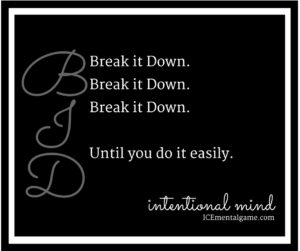
Everyone knows how to set a goal, like wanting to break a habit (popping a jump), or start a new habit (squeezing your arms in on rotation).
The challenge is how to get from making a goal to achieving the goal.
The Man on the mountain top had a dream, made a goal, then a plan, and committed every day to the plan to achieve his goal.
Most people look at a picture of this man on the top of the mountain with his arms held high over his head and say, “Wow, that Man is so athletic, he is exceptional, amazing, lucky he was born with good genes.”
They forget that:
- This Man started out at the foot of the mountain–one step at a time–no short cuts.
- A lifetime of training lead up to this particular ascent.
- At times the Man wanted to give up because it seemed like he would never reach the top.
- The Man didn’t do this all by himself. He had a team of experts and support.
What kept the man on track? Focusing on one baby step at a time.
Follow these four steps below and you will get from:
Having a Dream to Absolutely Nailing Your Goal
- Goal
- Plan
- Commit
- Tweak
Let’s get to work
The next part of the article is hands on. You will go through the process of breaking your dreams down into concrete steps that you can take right now.
Before you start, download and print your own worksheet.
Long Term Goals
Research shows that the youth athletes who make the most improvement have a goal (or their parents have one) when they start skating or playing. In my observation, this holds true for athletes and people of all ages.
You might already have a dream goal in your sport that will take you 2 years or more to reach. This is called a Long Term Goal (2-3+years).
- The skater in our example has two long term goals:
Land all triple jumps.
Qualify for Team USA.
1) Write your long term goal in the blank provided on your worksheet.
Now it’s time to break it down
A good long term goal is usually a stretch from where you are now. If you constantly reach for this goal, you can get frustrated and discouraged. You need a plan that allows the most improvement in the least amount of time so that you can get closer to your goal. That means breaking your large goal down into smaller more reachable pieces.
Take your Long Term Goal and break it down into a few Intermediate Goals. Intermediate Goals are skills or tasks that you can reach in the next 6 months to a year (or a season). These goals are usually steps you need to complete on the way your long term goal.
2) Decide on a few things that you would like to achieve this season that will help you improve and take you closer to your Long Term Goal. Write it down in the blank provided on your worksheet.
The skater in our example has three Intermediate goals:
- Pass Jr Freeskate test
- Get triple Salchow in program
- Get triple Toeloop in program

Create new goals weekly or monthly to keep you on track for the season
Start with your Intermediate Goals and break them down into steps, start with one for each month you have in the season. If those tasks have lots of steps, then continue to break the skills down to weekly goals. These are your Short Term Goals.
3) Start with this week (or month). Decide what you want to achieve in practice or competition this week. Write it down on your worksheet.
The skater in our example has short term goals for the week based on preparing for the Jr. Freeskate test:
- 3 double runthroughs
- rotate 2 Lutz 80% successfully
Immediate goals: The key to making progress is to stay in the moment
Your Short Term Goals can be broken down in to smaller goals called Immediate or Process Goals. These are small bite sized tasks that create success. These goals are simple, they are only about the process of the execution of skills (ex. stepping up in to the jump) instead of the outcome (ex. landing the jump).
4) Take the goal you want to accomplish by the end of the week or month (Short Term Goal) and break it down into smaller pieces. Decide what the one thing is that you need to do right now to execute the element successfully. Write it down on your worksheet.
The skater in our example has immediate goals for the week based on improving jumps in her program:
- Commit to jump
- Hit arm position
Immediate Goals need to be created every day. The same goals can be used more than one day, or even for the week.
This seems like a lot of work and it is. It means that you are working your mental game every moment you are on the ice. Focusing your attention on your Immediate or Process goals will keep you moving towards your Long Term Goal, just like the Man taking another step up the mountain.
Success will come if you keep your focus and attention mostly on your Immediate goals.
COMMITMENT
Now that you have a plan. You need to stick to that plan to make progress. Each day, as you create your Immediate Goals, you are committing to following your plan.
TWEAK
Because you are constantly setting your Immediate goals, you will know if you are moving in the right direction with your skills. Occasionally step back and check to make sure you are making improvement.
Ask yourself: Is what I am doing right now taking me closer to my Short Term Goals, Intermediate Goals (and ultimately my Long Term Goal)?
If not, adjust or “tweak” your goals to get you back on track
Note I said Tweak not scrap everything and start over. Stick to your plan as much as you can. The problem comes when an athlete gets discouraged over a week of poor practice and scraps everything and starts over–again and again. It’s a waste of time.

This is like the man looking up at the mountain top after every 5 steps and being discouraged that he has not gotten any closer to the summit and wanting to give up.
Of course if something is not working, tweak it, in drastic cases, pivot (change direction). But do it thoughtfully and with careful consideration.
5) Post your worksheet where you can see it and remember to focus on your Immediate or Process goals. Each week print a new sheet and write down your new immediate goals, or use post it notes to update them.
Summary:
Skating is a sport that a complement of both the physical and the mental. One day you are nailing jumps in practice and the next you aren’t. Evaluating your progress every day is pointless unless you have a strong mental game and are physically 100%. Fluctuations are expected, they could be mental or physical, or both.
Pay attention to your immediate goals more than your longer term goals. Before you know it you too will be on top of that mountain with your arms raised in the air.
Download the handy ICE Goals at a Glance Cheatsheet to keep you on track:

One Reply to “How to Absolutely Reach Your Goals”
Comments are closed.